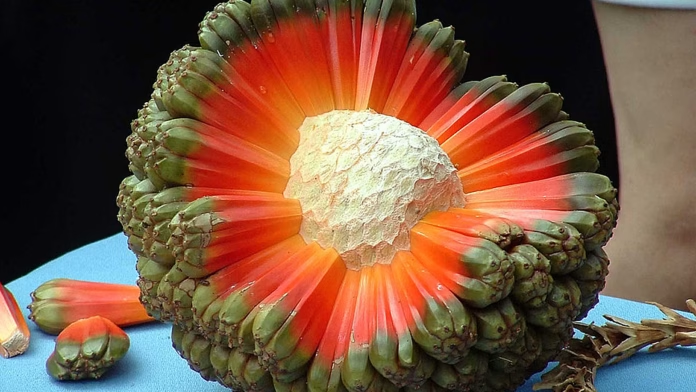Fruits are nature’s delightful creations, offering a burst of flavors and nutritional benefits. While we often indulge in popular fruits like apples, strawberries, and bananas, there is a vast array of lesser-known fruits waiting to be discovered.
In this article, we’ll explore ten rare fruits that you probably haven’t heard of before, each offering a unique taste and culinary experience.
- Ackee
Ackee, also known as ankye or akee, is a fruit that resembles an apple and belongs to the same family as lychee. Native to West Africa, it was introduced to Jamaica in the 1700s and is now considered the national fruit of the country. The ackee fruit has a nutty flavor with subtle sweetness and is often used in traditional Jamaican dishes such as ackee and saltfish. The fruit grows on evergreen trees and exhibits a vibrant color combination of yellow, orange, and red.
- Calamansi
Calamansi, also called calamondin, is a small citrus fruit that resembles a cross between a lemon and a lime. It has a green exterior and a bright orange interior. Native to the Philippines, calamansi is widely used in Filipino cuisine, adding a tangy flavor to various dishes. It is also a popular choice for making refreshing lemonade-style beverages. This unique citrus fruit is cultivated in Southeast Asian countries such as Sumatra, Borneo, and Indonesia.
- Quince
Quince is an intriguing fruit that appears to be a combination of a lemon, an apple, and a pear. It has a golden-yellow color and grows on bushes and small deciduous trees. While quinces may look soft and supple, they are actually rock-hard. When eaten raw, they have a sour and tart taste. However, quinces are commonly enjoyed cooked and are often used to make tart jams or marmalades. They can be found in various parts of Europe and can adapt to different climates.
- Cherimoya
Cherimoya, also known as custard apple, is a tropical fruit related to other uncommon fruits like sweetsop and soursop. This heart-shaped fruit has a sweet and creamy flesh, with a flavor often described as a combination of bananas, kiwis, and strawberries. Native to the Andes region in South America, cherimoyas are enjoyed raw or incorporated into creamy desserts such as ice cream, custards, and yogurts. Their unique taste and distinctive shape make them a captivating fruit to explore.
- Tamarillo
Tamarillo, sometimes called “tree tomatoes,” is a small fruit shaped like a duck’s egg. It is native to South America, particularly the Andean highlands. Tamarillos grow in bunches and come in various colors, ranging from red to yellow. While the fruit can be eaten raw, the skin is extremely bitter. Therefore, tamarillos are often incorporated into smoothies, jams, or baked goods like muffins. This fruit thrives in warm climates and adds a touch of exoticism to culinary creations.
- Feijoa
Feijoa, also known as pineapple guava, is grown on evergreen trees native to South American countries like Brazil, Paraguay, Argentina, Colombia, and Uruguay. This small, round fruit has a green skin and cream-colored flesh. Weighing between 80 to 120 grams, feijoas have a sweet and tart taste, reminiscent of strawberries and pineapple. They are adored for their perfume-like scent, which adds an aromatic element to any dish or dessert.
- Breadfruit
Breadfruit is a delicate fruit that shares close relations with jackfruit and mulberry-bearing varieties. Native to tropical regions like Southeast Asia and the Pacific, this green, oval-shaped fruit has a mild potato flavor when cooked. However, it can turn sweeter as it ripens. The scent of breadfruit is often compared to freshly baked bread, enhancing its appeal. With its unique texture and flavor, breadfruit offers an exciting culinary experience.
- Marang
Marang, also known as terap, green pedelai, or johey oak, is a large fruit with a distinct gasoline-like aroma. Despite its unusual scent, this fruit is highly regarded for its delicious taste, which combines hints of pineapple, pears, and jackfruit. Native to Asia, specifically tropical regions like the Philippines, marang grows on trees with broad leaves that can span up to four feet in length. Its rich flavors and captivating aroma make it a prized delicacy.
- Cupuaçu
Cupuaçu, also spelled cupuassu or cupu assu, is a brown-colored fruit that resembles a larger and smoother version of a cocoa bean. Native to the Amazon rainforest, cupuaçu grows on trees closely related to those that bear cacao fruit. The pulp of the cupuaçu fruit is used in various food products, including ice cream, butter, and snack foods. It can also be consumed raw, offering a unique and tropical flavor experience.
- Pawpaw
Pawpaw is a relatively unknown fruit native to North America, particularly the eastern US and Canada. Despite being less readily available in supermarkets, it stands as one of the largest edible fruit varieties on the continent. Pawpaws have bright yellow flesh and a delicious flavor that combines the sweetness of mangoes with the creaminess of bananas. The fortunate few who have tasted this delectable fruit cherish its rich and tropical taste.
Final Thoughts:
Exploring these rare fruits opens a world of culinary possibilities and introduces us to flavors and textures beyond the ordinary. From the nutty sweetness of ackee to the tangy zing of calamansi, each fruit has its own distinct character. So, the next time you come across one of these rare fruits, embrace the opportunity to embark on a culinary adventure and savor the taste of nature’s hidden treasures.





